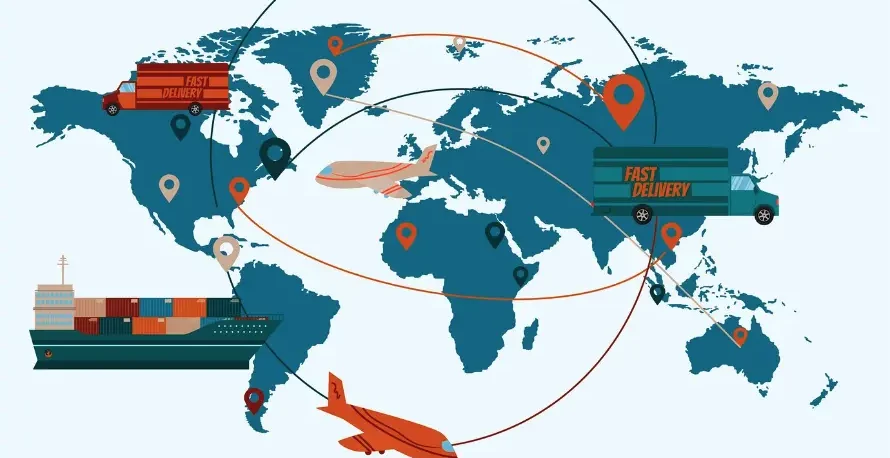August 17, 2022
Top Strategies for Global Supply Chain Management in Australia
The significance of robust global supply chain management continues to climb each year, particularly as the logistics sector bounces back from the impact of COVID-19. In the U.S., supply chain improvements accounted for about 8.7% of the GDP, and this percentage is projected to rise further.

This growth underscores a trend: consumers are increasingly demanding and expect their deliveries to be fast and flawless. So it’s clear that an efficient supply chain is not just a support function but a critical driver of business success in today’s fast-paced market.
What is Global Supply Chain Management?
A global supply chain management strategy is a comprehensive plan that outlines how a transnational company will manage the distribution of its goods and services worldwide. The primary objective is to maximize profit while minimizing waste, ensuring efficiency and effectiveness across the entire supply chain.
Managing a global supply chain involves overseeing the flow of goods and services from suppliers to customers, navigating the complexities of international logistics, and ensuring timely delivery. It’s about creating a harmonious operation where every part works in sync to meet customer demands and drive business success.
The roots of supply chain management stretch back to the 1960s, a time when the U.S. market was dominated by automotive titans like AMC, Mercedes, BMW, Porsche, and Jaguar. These companies set the stage for what would become a global phenomenon. Over the decades, the landscape of supply chains has evolved dramatically, expanding beyond national borders and becoming increasingly complex.
Read more: The Little Known Benefits Of Change Management in Digital Transformation
This forward-thinking approach to global supply chain management enables manufacturers to respond quickly to disruptions, reducing downtime and minimizing negative impacts on operations. By enhancing visibility, agility, and coordination across international networks, businesses can maintain continuity and competitiveness in volatile markets. The advantages are:
- Superior Customer Service: A well-prepared supply chain ensures timely and intact deliveries, significantly boosting customer satisfaction and loyalty.
- Precise Forecasting: By enabling accurate demand forecasting, manufacturers can better plan their production schedules, reducing the risks of overproduction or shortages.
- Optimal Capacity Utilization: Efficient use of resources results in higher productivity and lower operational costs, driving overall profitability.
- Minimized Overstocking: Optimized inventory management reduces excess stock and associated costs, contributing to a more streamlined and cost-effective supply chain.
Key Elements of a Global Supply Chain Strategy
The essential elements of an effective global supply chain management strategy technology revolve around seamless integration, cross-border coordination, and a comprehensive value chain perspective, specifically:
- Integration: Achieving seamless collaboration among all supply chain partners is like a symphony where each musician plays in harmony. Effective integration ensures that every link in the chain works towards shared goals, thereby enhancing overall efficiency.
- Coordination: This involves orchestrating all supply chain activities to ensure they function smoothly together. Proper coordination helps eliminate delays and bottlenecks, maintaining a consistent flow of goods and services.
- Value Chain Perspective: By identifying and optimizing every activity that adds value to a product or service, companies can reduce costs and enhance quality. Focusing on the value chain ensures that every step contributes positively to the end product.
Types of Global Supply Chain Models
In the bustling marketplace of the global economy, diverse supply chain models are the key players, each suited to the unique needs of multinational, global, and domestic companies.
The landscape of global supply chain management is shaped by a combination of market demands, technological advancements, cost pressures, and political as well as macroeconomic forces. These dynamics often introduce significant challenges—such as heightened foreign competition—that add complexity to managing operations across multiple regions. Understanding these factors is essential for businesses aiming to build resilient, adaptive supply chains. Here’s a closer look at the various models driving modern global supply chain management.
- Continuous Flow Model: Perfect for industries where stability is crucial. This model relies on consistent operations from both manufacturers and buyers, making it ideal for businesses with predictable and steady demand.
- Fast Chain Model: Tailored for companies that need quick turnaround times, such as those in the fashion industry or sectors that must swiftly adapt to market changes. This model supports rapid product cycles and quick market responses.
- Efficient Chain Model: Best for industries like manufacturing that depend heavily on automation. This model prioritizes efficiency and cost-effectiveness, ensuring high production levels at minimal costs.
- Agile Model: Suited for technology companies or those requiring high levels of customization and flexibility. This model emphasizes adaptability and quick responses to changing customer needs and market conditions.
- Individually Configured Model: Ideal for businesses needing extensive customization, such as the automotive industry. This model allows for tailored production processes to meet specific client requirements.
- Flexible Model: Designed for sectors needing a high degree of adaptability, such as healthcare. This model ensures that companies can quickly respond to changes and disruptions while maintaining service levels and operational efficiency.
Read more: Driving Results: 5 Strategy Technology Solutions Shaping Australia’s Future
Local Challenges in Australia’s Global Supply Chain Landscape
Despite its strong trading relationships and economic stability, Australia faces unique logistical and regulatory challenges that impact the efficiency of global supply chain management. Understanding these local issues is critical for building resilient operations:
- Freight Costs and Port Congestion: Australia’s geographic isolation and heavy dependence on international sea freight mean that businesses are especially vulnerable to rising shipping costs, delays, and port congestion. Limited port infrastructure in major cities like Sydney and Melbourne often leads to bottlenecks, while disruptions—such as strikes or global container shortages—can cause extended delays in inbound and outbound shipments.
- Trade Agreement and Regulatory Complexity: Navigating Free Trade Agreements (FTAs), tariffs, and customs compliance adds layers of complexity for companies importing or exporting goods. While FTAs with regions like ASEAN, the EU, and China offer advantages, they also require precise documentation, origin tracing, and understanding of legal terms—a burden for businesses without dedicated compliance teams.
- Talent and Labor Shortages in Logistic and Warehousing: Australia is currently facing labor shortages in key supply chain roles, including warehousing, transportation, and port operations. This talent gap is driving up wages and slowing down fulfillment speeds. To cope, many companies are investing in automation technologies, workforce upskilling, and digital supply chain tools that reduce reliance on manual processes.
Top Global Supply Chain Management Strategies
- Lean Thinking: Focus on eliminating waste and inefficiency within processes. Applying lean principles to manufacturing and supply chain operations can significantly improve efficiency and reduce waste.
- Building Relationships with Suppliers: Integrate suppliers into the supply chain by sharing information and granting them direct access to consumer data. This proactive approach reduces uncertainty and fosters better collaboration.
- Information Sharing: Transparent communication throughout the value chain can mitigate the “Bullwhip Effect” and add overall value. Effective information sharing improves coordination and responsiveness.
- Improving Interdepartmental Coordination: Ensure that internal information flows are well-planned and functioning smoothly. Effective coordination between departments can reduce operational uncertainties.
- Scenario Planning and Testing: Prepare for various potential disruptions by testing the supply chain’s response to best and worst-case scenarios. This helps companies build resilience and be better prepared for unforeseen events.
- Technology Integration: Seamlessly integrate advanced technologies through IT systems to facilitate quick reactions to significant disruptions. Real-time monitoring and swift decision-making enabled by technology can reduce risk and uncertainty.
Best Practices for Building a Future-Ready Supply Chain in Australia
n an era of global uncertainty, digital disruption, and rising customer expectations, future-proofing your supply chain is no longer optional—it’s essential for long-term business success. For Australian enterprises that rely on international suppliers, regional logistics networks, and time-sensitive operations, applying best practices in global supply chain management can drive resilience, agility, and competitive advantage. Here’s how:
- Strengthen Supplier Relationships: Build long-term contracts and trust to ensure stability during disruptions.
- Create Cross-Functional Teams: Unite logistics, finance, and IT for faster, smarter decision-making.
- Track Key Metrics: Monitor OTIF, lead times, and inventory turnover to improve performance.
- Leverage Expert Partners: Work with supply chain consultants and tech providers to boost automation, visibility, and risk management.
By adopting these best practices, Australian companies can build resilient, adaptive, and forward-looking supply chains—ones capable of withstanding global shocks while driving operational excellence and customer satisfaction.
Why Choose SmartOSC as Your Global Supply Chain Technology Partner
In today’s increasingly complex and digitally connected logistics landscape, businesses need more than just software—they need a strategic partner who understands how to align technology, compliance, and operational efficiency. That’s where SmartOSC stands out.
With nearly two decades of experience in enterprise digital transformation, SmartOSC has worked with global brands across retail, manufacturing, logistics, and finance to develop tailored digital supply chain solutions. From eCommerce platforms integrated with inventory management to data-driven analytics dashboards for procurement and logistics visibility, SmartOSC brings both technical expertise and real-world supply chain understanding.
Key reasons to choose SmartOSC:
- Experience with complex, multi-regional architecture, including supply chain platforms, ERP, OMS, and CRM integration
- Deep understanding of compliance across regions, including data handling, PDPA, GDPR, and industry-specific standards
- Capabilities in automation, real-time visibility, and custom dashboard development to monitor shipments, partners, and inventory
- Local and APAC-wide teams providing regional insight, language support, and agile delivery
- Proven success helping companies scale cross-border operations across Southeast Asia, ANZ, Europe, and beyond
SmartOSC isn’t just a vendor. It’s a digital supply chain enabler—equipping Australian businesses with the tools and strategies to manage complexity, reduce risk, and thrive in global commerce.
Conclusion
In a world where consumer expectations are higher than ever, effective global supply chain management strategies are crucial. It ensures that companies can deliver products efficiently, maintain competitive advantage, and achieve sustainable growth. And that’s where SmartOSC comes in.
We specialize in developing data-driven operating models that seamlessly integrate intelligent technologies, skilled talent, and advanced data analytics – This approach delivers real-time, actionable insights that optimize your operations. Reach out to us, and we will not only streamline your processes but also boost customer satisfaction and drive profitability.
Related blogs
Learn something new today


